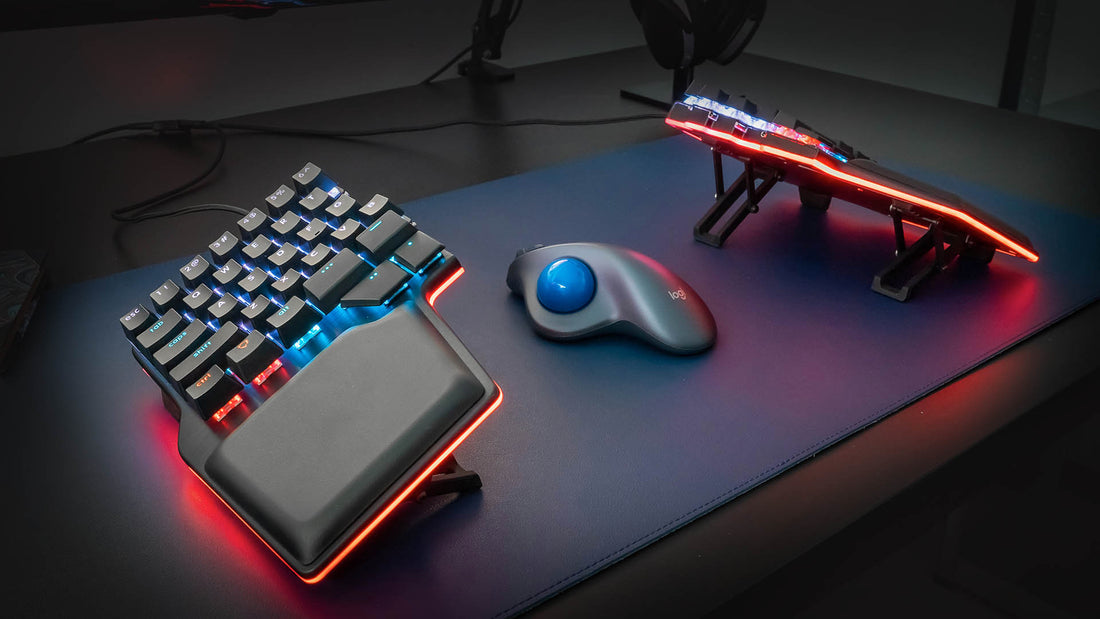Repetitive strain injuries are common, if you work in an office, you might have noticed that you or your coworkers experience symptoms like:
- Tingling or loss of sensation in your fingers.
- Clumsiness, weakness, or permanent cold in your hands.
- Back or neck pain.
Most of the time, people take them lightly. They treat them with painkillers or some other temporary solution.
Ignoring or partially treating these symptoms is dangerous since they can lead into a more serious injury.
We'll help deal with these problems with some ergonomic setup advice, specific exercises, and good habits in order to help you prevent repetitive strain injuries (RSI).
What is repetitive strain injury (RSI)?
Repetitive strain injury is a cumulative trauma disorder (CTD) that originates from the repetition of forceful and awkward movements. It can lead to serious damage to the muscles and tendons of your arms.
In other words, it's an injury produced by the repetition of seemingly harmless movements.
It includes a whole spectrum of conditions, from tendonitis of the hand or wrist, to carpal tunnel syndrome to cubital tunnel syndrome.
Activities that involve continuous typing or mouse usage can lead to RSI-related injuries. The problem is that most of the time, we simply ignore the signals until it's too late.
Fortunately, there are ways to prevent RSI: healthy habits in and out of work, improving your technique and posture, and an ergonomic setup. These can be game-changers for this serious matter.
How can we really prevent RSI?
1. Awareness
Well, the first thing is awareness. As we said, don't ignore any pain or discomfort. Listen to your body and treat it with care.
If you feel any symptoms, have them checked by a healthcare professional. Don't underestimate them because they can lead to serious injuries.
2. Workstation
Second, your work environment:

Your Keyboard
Position it so you can reach all the keys with your arms in a neutral position, meaning with your elbows at your side and bent at 90 degrees, and your forearms parallel to the ground.
Split mechanical keyboards, like the Dygma Raise, are ideal to reach this neutral position since they can be adjusted to the user's needs, and more importantly, they can be adjusted easily to different positions, avoiding the "repetitive" part of the RSI.
These keyboards can also be customized, which means you'll be able to rearrange the keys for a more ergonomic setup. For instance, you can rearrange all the "pinky keys" like shift, enter or backspace and place them in the thumb keys, saving your hand a lot of unnecessary movements.

If you are a Python programmer, you are in deep need of the dash and the underscore keys, why not configure them to your thumb keys in order to reduce hand movement?
You can also rearrange your keyboard to the Colemak layout; an update of the traditional QWERTY layout. Designed to help the typists by focusing the keystrokes in the home rows, and hence reduce strain on typists.
It was originally designed for English, but it's easy to adapt to almost any language, here's an example of a Spanish Colemak layout:

The Raise, and other ergonomic split keyboards, allow you to create macros.
Macros are sequences of events (such as keystrokes, mouse clicks, and delays) that can be played back to help with repetitive tasks. They can also be used to replay sequences that are long or difficult to run.

Your Mouse
The mouse has to be placed just to the side of the keyboard, as close as possible to avoid stretching your arm more than necessary. If you want to reduce the hand movement even further, consider getting yourself a trackball mouse. This way you can use the mouse without needing to move your arms and shoulders. They might take some time to get used to, and some people might not be a fan of the design, but they are, by far, the best option to reduce hand movement to zero.
If you want a more comfortable setup, you can even place the mouse in the middle of your split keyboard. This will make you work more efficiently, saving time and being able to use more gadgets in less space.

Dygma Raise on tenting kit with Logitech trackball mouse
If you don't have a large surface or you are not keeping the halves of the keyboard far apart, try using a higher sensitivity, it will reduce both space and movement required to work with the mouse.
While gaming, avoid excessive wrist use, try a lower sensitivity so you have to move your shoulder and elbow.
Your Monitor
Place the monitor in front of you and have the middle section just below eye level. It should be around 50 to 70 cm (20 to 27 inches) away, depending on the measurements of the monitor.
One final consideration; if you use glasses, place the monitor slightly lower in order to adjust the way you look through the lens.

Looking at the screen is probably the most repeated action of your workday. Placing it in the wrong position will lead to thousands of hours sitting with a bad posture or will result in you turning your head to your second monitor several times throughout the day.
Either way, the mispositioning of your monitors can lead to neck and back problems, so don't take it lightly 😊
Your Desk and Chair
Ideally, both should be adjustable so you can change your posture any time you want. But at least, you need to be able to adjust one, otherwise, the neutral position we described for the keyboard won't be attainable.
Don't let your wrists rest on your table while typing, doing so will increase the required movement to reach some keys, and leaning the wrists on the desk puts more pressure on the undersides of the wrists, which can be a factor to develop carpal tunnel syndrome (CTS)
To prevent it, make sure that your elbows and wrists are above your keyboard while typing, also, proper palm rests and a good typing technique will come in handy to avoid these problems.

The setting of your workstation will determine your posture and your movements. You might think that the posture is what determines the workstation, but it's the other way around.
Case in point, laptops.

It's almost impossible to attain a good ergonomic posture working on them. The keyboard is too small and the position of the screen is too low, if you want to work with a laptop on a day-to-day basis, you need to lift the screen and get a keyboard, so you have to build a workstation to make it viable.
3. Habits
Third, your habits.
Yes, the workstation determines your posture and movements in your day-to-day activities. What you do outside of it is up to you and it has a great impact on your productivity, so you probably want to take a look at it too.
Exercise:
Do it at least twice a week. Try to strengthen your core, your neck, and your upper and lower back. But overall, try to have a more active lifestyle. If you can walk or ride a bike to work, do it, if not, take a long walk after you're done working, or even better, while you are working.
Hydration:
Drink more water and less coffee. It will help you reduce both stress and muscular fatigue.
Take breaks:
Don't sit for 4 hours straight, never! Take a break, move around, lay down and meditate, talk to a colleague or walk your dog. Anything to stand up from the desk, preferably once every hour, and move around for at least two minutes. If necessary, set an alarm every once in a while, but stand up and change positions frequently.
Stretching:
It doesn't matter if you feel pain or not, stretching during your breaks is the best way to prevent RSI. Here are some exercises you can try any time and anywhere and they're all great for pain and stress relief.
Wall stretch: Ideal for those who don't have much time to spare, it works on the shoulder, the arm, the wrist, and the hand all at once. Simply extend your arm along the wall, parallel to the ground with your palm facing the wall. Extend your arm and fingers as much as you can, and hold for 30 to 60 seconds.
Postural exercise: Great to prevent and fight back pain. Just find a wall, bend your knees and lean touching the wall with the whole surface of the back. Hold the position and control your breathing for about 15 to 20 seconds. You can also lift the arms to further strengthen your posture.
Wrist stretching: Focused on the wrists and the forearms. Twisting your wrists in both directions helps to relieve a lot of stress, and stretching the zone is always a good idea. To do so, extend your arm, and stretch your wrist for about 30 seconds in each direction.
Unfortunately, prevention is not enough. Sometimes injuries present themselves in a sudden manner, or the pain appears too late. If things reach that point, stop working until you can visit a medical professional, because you will only make things worse in the long run.
Repetitive strain injury can develop into more serious issues if not treated correctly. We're talking about surgery and the inability to type again in some serious cases. So, don't ignore any of the symptoms.
RSI can have a serious psychological impact as well. Losing the ability to perform certain tasks is a major source of frustration. Don't disregard the mental aspect of any injury if you want to properly prevent and recover from it.
On a lighter note
Yes, RSI can be a huge issue, but we have all the tools to fight it within our reach.
Add more exercises to your routine, take proper breaks and surround yourself with an ergonomic setup. In the end, that's where you're spending most of your time. So spending money on a good chair, a proper table, and the right ergonomic keyboard and mouse is an investment for your health and productivity.
The Dygma Raise is designed to help with RSI prevention. Its split design is essential for a better posture, as it allows you to sit straight by splitting the keyboard shoulder-width apart. This will reduce the stress in your back.
Its software provides customization tools to optimize your layout, helping to reduce finger torsion. In addition, the palm rests help your wrists be at a neutral angle, altogether, helping to reduce the stress in your hands
Why not give it a try? Get your ergonomic split keyboard at our shop now!









